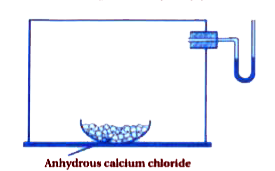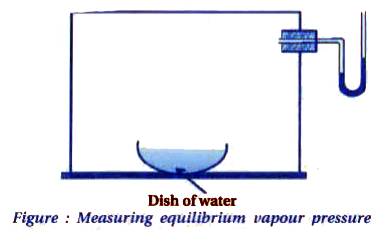Describe measuring equilibrium vapour pressure of water at a constant temperature.
Text Solution
Process : We consider the example of a transparent box carrying a U-tube with mercury (manometer). Drying agent like anhydrous calcium chloride (or phosphorus penta-oxide) is placed for a few hours in the box. By doing this air in the box is free from vapour (moisture). (see fig.)
Now, after removing the drying agent by tilting the box on one side, a watch glass (or petri dish) containing water is quickly placed inside the box.

Observation : It will be observed that the mercury level in the right limb of the manometer slowly increases and finally attains a constant value.
Assumption : The observation shows that (i) In the beginning the pressure inside the box increases. (ii) After some time pressure inside the box becomes constant. (iii) The volume of water in the watch glass decreases.

Description : Initially there was no water vapour (or very less) inside the box. As water evaporated the pressure in the box increased due to addition of water molecules into the gaseous phase inside the box, [H2O→H2O(vapour)] So, the rate of evaporation is constant.
The rate of increase in pressure decreases with time due to condensation of vapour into water.[H2O(g)→H2O(l)] While water is converting from gases to liquid form, atoms are increasing. After some time pressure become constant. There is equilibrium in box as rate of evaporation and rate of condensation become equal.
Rate of evaporation (H2O(l)→H2O(g)) = Rate of condensation (H2O(g)→H2O(l)) .....(i)
∴ at the equilibrium stage H2O(l)⇔H2O(vapour)
At equilibrium the pressure exerted by the water molecules at a given temperature remains constant and is called the equilibrium vapour pressure of water (or just vapour pressure of water), vapour pressure of water increases with temperature.
Water and water vapour are in equilibrium position at atmospheric pressure (1.013 bar) and at 100∘C in a close vessel. The boiling point of water is 100∘C at 1.013 bar pressure. For any pure liquid at one atmospheric pressure the temperature at which the liquid and vapours are at equilibrium is called normal boiling point.
|
Topper's Solved these Questions
- EQUILIBRIUMBOOK - KUMAR PRAKASHANCHAPTER - EQUILIBRIUMEXERCISE - SECTION-A Try Your self -2
6 Videos
- EQUILIBRIUMBOOK - KUMAR PRAKASHANCHAPTER - EQUILIBRIUMEXERCISE - SECTION-A Try Your self -3
10 Videos
- ENVIRONMENT CHEMISTRY BOOK - KUMAR PRAKASHANCHAPTER - ENVIRONMENT CHEMISTRY EXERCISE - Question For Module (Section-C)
1 Videos
- HYDROCARBONSBOOK - KUMAR PRAKASHANCHAPTER - HYDROCARBONSEXERCISE - (Questions for Module (Section - D))
1 Videos
Similar Questions
Knowledge Check
Alcohol has….vapour pressure than water at the same temperature
AmoreBlessCsameDnoneAt a certain temperature, the vapour pressure of water is 90 mm. At the same temperature the vapour pressure of a solution containing a non - volatile solute is 81 mm. The relative lowering of vapour pressure is
A9B0.9C10D0.1The vapour pressure of a solution of 5g of non-electrolyte in 100g of water at a particular temperature is 2985Nm−2. The vapour pressure of pure water at that temperature is 3000Nm−2. The molecular weight of the solute is
A180B90C270D200
Why is the vapour pressure of liquid constant at a constant temperature ?
View SolutionDescribe liquid-vapour equilibrium
View SolutionIn liquid gas equilibrium, the pressure of vapours above the liquid is constant at
View SolutionThe vapour pressure of solution containing 5 g of non-electrolyte in 90g of water at a particular temperature is 2985 Nm–2. The vapour pressure of pure water at that temperature is 3000 Nm–2. The molecular weight of the solute is –
View SolutionWhich of the following is defined as the ratio of the partial pressure of water vapour in a parcel of air to the saturated vapour pressure of water vapourata prescribed temperature?
View Solution
